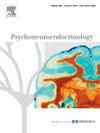Salivary cortisol trajectories among inpatients undergoing substance use disorder treatment: A prospective repeated-measures study
IF 3.6
2区 医学
Q2 ENDOCRINOLOGY & METABOLISM
引用次数: 0
Abstract
Background
A growing body of research among inpatients with substance use disorders (SUD) suggests a link between cortisol levels and treatment outcomes. However, there is limited insight into the pattern of cortisol level during an inpatient SUD treatment stay.
Aim
The aim was to investigate changes in salivary cortisol levels during 8 weeks of an inpatient SUD treatment stay, and to determine whether the primary SUD diagnosis exerted a distinct effect on cortisol level trajectories.
Methods
We employed a prospective repeated-measures design and followed a cohort of patients with various SUD diagnoses. Salivary cortisol samples were collected at four time points during the first 8 weeks of the treatment stay (t1: week 2 (baseline); t2: week 4; t3: week 6; and t4: week 8). We assessed basal cortisol concentration by calculating the area under the curve with respect to ground (AUCG), which represents total daily cortisol output. Associations were determined using Linear mixed model analyses (LMMs).
Results
The analytic sample comprised 173 patients. The full LMM model, including covariates (i.e. polysubstance disorder, age, gender, treatment history, treatment unit, mental distress) revealed that cortisol levels decreased from t1 to t2 (β = –7.218; 95 % CI: –11.126 to −3.310; p < 0.001) and stabilized thereafter. Patients with opioid use disorders (OUD) had lower cortisol level trajectories than patients with stimulant use disorders (β=-20.357; 95 % CI: −29.394 to −11.319; p < 0.001), while patients treated in the long-term unit showed elevated cortisol trajectories relative to those in the short-term unit (β=6.650; 95 % CI: 0.072–13.229; p = 0.048).
Conclusion
This study showed a decline in cortisol levels during the first 4 weeks of SUD inpatient treatment, followed by stabilization. Patients with stimulant use disorders had higher cortisol levels over time than those with OUD. Further research should explore the clinical implications of the current findings. In particular, greater insight into the moderating effects of polysubstance disorders on cortisol levels may contribute to the development of individual tailored treatment approaches.
接受药物使用障碍治疗的住院患者唾液皮质醇轨迹:一项前瞻性重复测量研究
背景:越来越多的药物使用障碍(SUD)住院患者的研究表明皮质醇水平与治疗结果之间存在联系。然而,对住院患者SUD治疗期间皮质醇水平模式的了解有限。目的:研究8周SUD住院治疗期间患者唾液皮质醇水平的变化,并确定原发性SUD诊断是否对皮质醇水平轨迹有明显影响。方法采用前瞻性重复测量设计,对诊断为不同SUD的患者进行随访。在治疗前8周的四个时间点收集唾液皮质醇样本(t1:第2周(基线);T2:第4周;T3:第6周;t4:第8周。我们通过计算相对于地面(AUCG)的曲线下面积来评估基础皮质醇浓度,AUCG代表每日总皮质醇输出。使用线性混合模型分析(lmm)确定相关性。结果分析样本包括173例患者。完整的LMM模型,包括协变量(即多物质障碍、年龄、性别、治疗史、治疗单位、精神困扰)显示,皮质醇水平从t1到t2下降(β = -7.218;95 % CI: -11.126至- 3.310;P <; 0.001),此后趋于稳定。阿片类药物使用障碍(OUD)患者的皮质醇水平轨迹低于兴奋剂使用障碍患者(β=-20.357;95 % CI:−29.394 ~−11.319;P <; 0.001),而长期单元治疗的患者相对于短期单元治疗的患者表现出升高的皮质醇轨迹(β=6.650;95 % ci: 0.072-13.229; = 0.048页)。结论:本研究显示,在SUD住院治疗的前4周,皮质醇水平下降,随后趋于稳定。随着时间的推移,兴奋剂使用障碍患者的皮质醇水平高于OUD患者。进一步的研究应该探索当前发现的临床意义。特别是,更深入地了解多物质障碍对皮质醇水平的调节作用,可能有助于开发个性化的治疗方法。
本文章由计算机程序翻译,如有差异,请以英文原文为准。
求助全文
约1分钟内获得全文
求助全文
来源期刊

Psychoneuroendocrinology
医学-精神病学
CiteScore
7.40
自引率
8.10%
发文量
268
审稿时长
66 days
期刊介绍:
Psychoneuroendocrinology publishes papers dealing with the interrelated disciplines of psychology, neurobiology, endocrinology, immunology, neurology, and psychiatry, with an emphasis on multidisciplinary studies aiming at integrating these disciplines in terms of either basic research or clinical implications. One of the main goals is to understand how a variety of psychobiological factors interact in the expression of the stress response as it relates to the development and/or maintenance of neuropsychiatric illnesses.
 求助内容:
求助内容: 应助结果提醒方式:
应助结果提醒方式:


